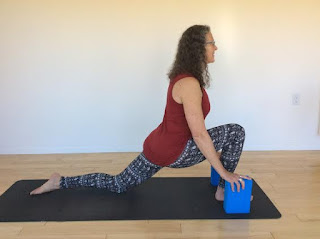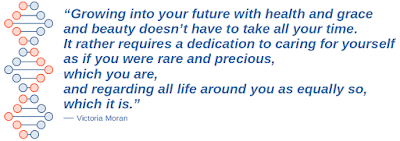Do you think the photograph above is an example of healthy hips? If so, you might want to think again. The photograph above is of yoga teacher Jill Miller BEFORE she had a total hip replacement - at age 45! However impressive this photo seems, it is, in reality a picture of hypermobility - also known as double-jointedness, in which joints stretch farther than normal.
In Jill’s case, years of hypermobility led to “picture-perfect” yoga poses—and 7 years of chronic pain! Her overuse injuries ultimately prompted her total hip replacement. After the surgery, she switched from the way she practiced yoga in her younger years and transitioned to a more hip stabilizing practice. Fortunately, she is still teaching yoga today. 1
Hypermobility can set the stage for the degeneration of the hip and other joints. However, anyone, at any age, for almost any reason can experience issues with their hips. An active lifestyle, athletic pursuits, and genetics may also contribute to hip issues. 2
No one wants to end up with a hip so unhealthy a saw is required to fix it! What you really want to focus on is hip mobility, NOT hypermobility. Mobility is what allows you to move comfortably through your daily activities like bending down to tie your shoes, reaching for items on a grocery store shelf, and working in your garden. Although it might make an impressive picture, you don’t need to perform hypermobile hip poses. In fact, hypermobility may indicate destabilization of your joints – that's not healthy! 3
Balancing Strength and Flexibility for Healthy Hip Mobility
Hip strength is the first component of hip mobility. If the muscles, tendons, and ligaments that support your hip joints are weak, it can interfere with walking and running. Weak hips allow you to will sink into the ground with each step instead of rebounding forward. This weakness can lead to injury over time as your joints are strained by too much torque. Support from strong muscles, tendons, and ligaments stabilize your hip joints and prevent injuries.
Hip flexibility is the second component of hip mobility. As you age, your ligaments change, your muscles and fascia may tighten, which increases stiffness and decreases flexibility. A sedentary lifestyle and excessive sitting are a couple more reasons for why you develop stiff hips which limit your range-of-motion. This can then limit your ability to squat which, in turn, affects your ability to complete daily tasks like caring for grandchildren or pets. 4
How Healthy Are Your Hips? - testing for strength and flexibility
These self-tests will establish a benchmark which enables you to gauge improvement. First, you will test your hip strength. Next, you will test your hip flexibility.
SKIP THE TESTS! If you’re not able to stand on one foot safely, have balance issues, or have had hip replacement surgery - start by talking to your doctor about your current health and work with your doctor to find the right plan for you.
1. CHECK YOUR HIP STRENGTH 6
Can you stand on one leg with your other knee parallel to the floor for 10 seconds?
This quick test can give you clues about the strength of your hip flexors—as well as the strength of your glutes and core.
The Test: You’ll need a sturdy chair or workout box. You may also want to perform this near a wall that you can hold on to if needed and place the chair on a non-skid surface.
If You Were Able to Stand with Good Form for 10 Seconds on Each Leg:
That’s a sign your hip flexors, glutes, and core are in good health. Specifically, it means they’re working together to keep you stable—as you walk, climb stairs, step over obstacles, and generally stay active.
If You Weren’t Able to Maintain Good Form, Couldn’t Hold for 10 Seconds, or Noticed a Big Difference Between Sides
That’s a sign you may have some muscle imbalances caused by weakness in the hip flexors, glutes, or core.
2. CHECK YOUR HIP FLEXIBILITY
This 3 ½ minute video from Dr. Joel Eaby Physical Therapy does a good job of demonstrating the self checks for flexibility – internal rotation, external rotation, flexion, and extension of the hip.
YOUR GOAL: HIP MOBILITY
 |
| annwestyoga.com |
Most of us could benefit from working on our hip mobility issues. There are a total of 22 muscles that cross the hip on all sides and at varying angles, including your hip flexors in the front, your hamstrings, glutes, and deep lateral rotators in the back, your inner thigh muscles (collectively called your “adductors”), and your outer thigh muscles (collectively called your “abductors”).
Technically any yoga pose that lengthens any of the 22 muscles that cross the hip improves hip mobility. This means, for example, that all hamstring stretches, all inner thigh stretches, all standing poses, many twists are hip-openers, and as counter-intuitive as it may seem, all back bends are also “good” for hip mobility.
Yoga poses create a balance between strength and flexibility in the hips – front to back and side-to-side. When flexibility is combined with strength and control you are able to maintain mobility.
Your goal is to safely stretch and release the muscles of the hips and legs while cultivating a healthy balance between strength and flexibility. 7
Here are some yoga poses to help keep your hips happy and healthy! 8
As with any physical activity, remember - you must move with the body you have at this moment, not 10 years ago, 10 months ago, 10 weeks ago, 10 days ago or even 10 minutes ago. Remember - move with care. A supported variation for each pose is offered.
- From a standing position, lower yourself to kneel on one knee. Make sure the other knee lines up over your ankle.
- Pull the hip of your kneeling knee back so that it is in line with your opposite hip.
- Lift your arms overhead and overlap your thumbs.
- Pull your tailbone downward to avoid overarching your lower back.
 |
Supported Low Lunge with blocks
|
Lizard Pose
- From a standing position, lower yourself to kneel on one knee. Make sure your forward knee is over your ankle, and roll your foot slightly to the outside to open your bent leg.
- Lean forward and place your hands on the mat to the inside of your foot.
- For a less intense stretch, keep the forward foot flat on the mat rather than rolling onto the outside edge.
- For a more intense stretch, lean forward further and place your elbows on the mat.
 |
Supported Lizard with blocks, arms extended or bent
|
Reclined Half Pigeon
- From a sitting position, lie on your back, knees bent.
- Place the ankle of one leg on the knee of the other.
- Bring your legs toward your chest and hold the bent leg with your hands.
- Keep toes of both feet flexed.
- For a deeper stretch, reach for the bottom leg and pull toward your chest gently.
 |
| Supported Reclined Half Pigeon on the Wall |
|
Reclined Cobbler’s Pose
- Lie on your back with the soles of your feet together, knees splayed to the outside.
- For a less intense stretch, slide your feet away from your body.
- For a more intense stretch, walk your feet closer to your body and place your hands on your inner thighs.
- To move out of the pose, use your hands to guide your knees together.
 |
| Supported Reclined Cobbler's Pose with pillows |
1.
https://www.yogajournal.com/lifestyle/inside-my-injury-how-i-ended-up-with-a-total-hip-replacement-at-age-45/?utm_medium=social&utm_source=email&utm_campaign=onsiteshare
2.
http://sacredsourceyoga.com/physicaltherapy/yoga-and-your-hips-deciphering-femoroacetabular-impingement-and-labral-tears/
3.
https://singaporeosteopathy.com/2015/05/03/joint-hypermobility-beyond-the-normal-range-of-movement/
4. Rountree, S. H.
(2017). The runner's guide to yoga. Carrboro, NC: TIPS
Technical Publishing.
5.
https://squatuniversity.com/2015/12/01/the-squat-fix-hip-mobility-pt-1/
6.
https://youtu.be/dcOEUVSOiSc
7.
Rountree, S. H., & Desiato, A. (2017). Lifelong
yoga: Maximizing your balance, flexibility, and core strength in your
50s, 60s, and beyond.
Berkeley, CA: North Atlantic Books.
8.
https://health.clevelandclinic.org/yoga-poses-that-can-stretch-your-hip-muscles/
















































